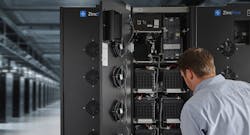How to Make the Most out of UPS Battery Retrofits
Some newer technologies, including lithium-ion, pose challenges in replacing a lead-acid based system, since they require additional safety considerations. Additionally, with changes to recent Codes and Standards, it can be more difficult to gain approvals from authorities having jurisdiction (AHJ) for this change in battery chemistry. Unless batteries are replaced with counterparts of the same type and size (with no more than 10% additional capacity), the replacement will have to be permitted as new installation.
Some battery types have a significantly reduced maximum capacity limit under both the NFPA 1 (and NFPA 855) and the International Fire Code. In addition to reduced capacity, some will require additional fire and explosion control systems and upgraded fire-resistant separations from other areas. These issues can complicate and add expenses to the retrofit process, so data center operators can become wary of retrofitting new chemistries. As a result, they continue to retrofit with lead-acid batteries and miss out on the benefits of making a switch.
Fortunately for data center operation teams, some battery solutions on the market today allow them to reap the benefits of more advanced technologies without worrying about complex approval processes, unnecessary costs, or safety risks. For instance, nickel-zinc chemistry offers data centers the best of both worlds: a smooth and pain-free retrofit resulting in a more reliable, sustainable, and long-lived battery system.
While lead-acid batteries have the advantage of familiarity, newer chemistries outperform them in several ways. Lithium-ion and nickel-zinc (NiZn) batteries are proven chemistries that save data centers money with their 10-15 year lifespan, up to three times as long as lead-acid batteries’ average five-year operating life. According to The iMasons’ Climate Accord, there are 100GW of built data center capacity globally. Roughly over half of the annual battery replacement market in data centers is the cost of replacing existing lead-acid batteries. By replacing these with one of the newer technologies, the operator can realize a real total cost of ownership (TCO) advantage over the operating life of the facility. This increased life expectancy can save the operator 30% to 50% in replacement operational expenditures over the life of the longer-lasting batteries.
Nickel-zinc batteries also offer greater reliability, which helps avoid costly power shortages for data centers – no small thing when over 60% of power failures result in at least $100,000 in total losses. A single failed cell in a lead-acid or lithium battery can cause the entire battery string to fail. This reduces runtime significantly and requires an expensive emergency maintenance visit to avoid the risk of power backup capacity failure. In contrast, depleted nickel-zinc cells allow the battery string to continue operation with no emergency maintenance, and no risk of backup power unavailability.
Companies have also come under pressure from investors, regulators, and the public to record and reduce their supply chain emissions. Nickel-zinc batteries’ greenhouse gas emissions footprint is four times lower than lead-acid batteries, and their production avoids toxic materials. These improvements in sustainability, including ready recyclability, help data centers attract clients developing and pursuing ambitious ESG goals.
This array of sustainability, reliability, and cost benefits makes certain new chemistries more than worthwhile – but there’s a reason data center operators might pause before moving on from lead-acid. Since most data centers were built to house lead-acid batteries, installing alternatives can sometimes be complex. While this can’t be said for all new chemistries, some do offer a hassle-free, straightforward process that lets operators access their benefits without having to face the headache of redesign.
Nickel-zinc batteries are incapable of thermal runaway, which eliminates the need for extra safety measures and equipment that lithium-ion batteries require. NiZn batteries are accepted by NFPA, listed in NFPA 855, and accepted in IFC Codes and Energy Storage Standards using the Hazard Mitigation Analysis (HMA) process. They can ship in fully populated cabinets and are backwards-forwards compatible with traditional UPS systems designed for lead-acid batteries. These characteristics provide a smooth retrofit and a way to maximize battery benefits without the vexation of a complicated re-design and approval process.
While lead-acid batteries are familiar, new chemistry retrofits offer the chance to expand capacity with better long-term solutions. Nickel-zinc batteries balance both priorities by boosting UPS system’s reliability, sustainability, and long-term savings with a straightforward deployment. In the end, it's more than just an upgrade—it's a strategic move toward a sustainable and reliable future.
Tod Higinbotham is COO of ZincFive. Contact them to learn more about their nickel-zinc batteries.



